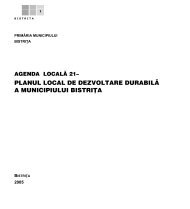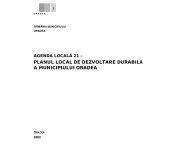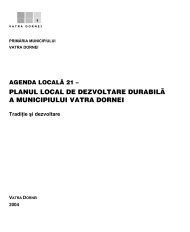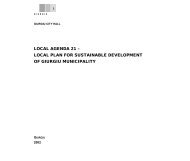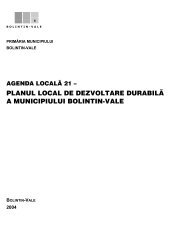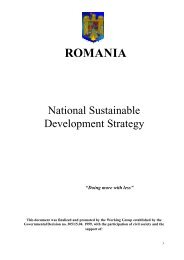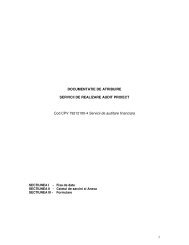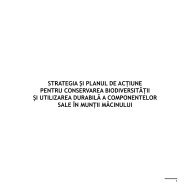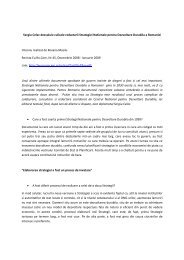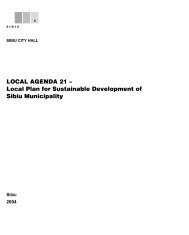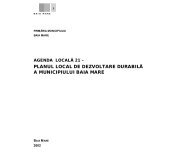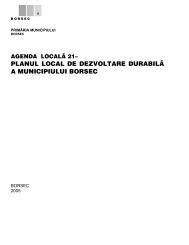local agenda 21 local plan for sustainable development of bistriþa ...
local agenda 21 local plan for sustainable development of bistriþa ...
local agenda 21 local plan for sustainable development of bistriþa ...
You also want an ePaper? Increase the reach of your titles
YUMPU automatically turns print PDFs into web optimized ePapers that Google loves.
BISTRITA<br />
13<br />
I.1 ASSSESMENT OF THE NATURAL<br />
CAPITAL<br />
I.1.1 Geographic position – lat/ long. 47.1˚ N<br />
24.5˚E<br />
Bistrita municipality, which is part <strong>of</strong> the county <strong>of</strong><br />
Bistrita-Nasaud, is situated in the Bistrita depression,<br />
on the lower course <strong>of</strong> river Bistrita Ardeleana at the<br />
altitude <strong>of</strong> 358 m. The town has a central-southeastern<br />
position within the county.<br />
The Bistrita depression <strong>for</strong>ms part <strong>of</strong> Bistrita Hills, a<br />
subdivision <strong>of</strong> the Transylvania Plateau, between the<br />
Somesul Mare passage to the north and north-west;<br />
the Dipsei Valley running until Sirisoara, and further<br />
on, the Sieului Passage, running until the junction with<br />
Somesul Mare, to the south-west; to the east, the hill<br />
runs a few hundred meters towards the Calimani and<br />
Bargau mountains.<br />
The Bistrita depression is connected to the Sieului<br />
passage to the south-west, and closed in by the<br />
Sieului peak; while to the north-east it continues with<br />
the Livezile-Bargau passage.<br />
The hilly peaks guarding the city are oriented in an<br />
north-east to south-east direction and are represented<br />
by the Fortress Hills to the north-west (Fortress Hill,<br />
680 m, Ruja Hill, 475m, Schulerwald, Hill 469m, Hebal<br />
Hill, 546m), Mocilor (Jelnei), 607m, and Budacului,<br />
475m, to the southeast.<br />
I.1.2 Relief<br />
Due to its mountain relief with rich flora, the<br />
microclimate in Bistrita has the characteristics <strong>of</strong> a<br />
<strong>local</strong>ity situated at a higher altitude than is the case –<br />
at 350 m.<br />
I.1.3 Climate<br />
Due to its geographical position, Bistrita-Nasaud<br />
county is situated in an area characterised by a<br />
moderate continental climate influenced by air masses<br />
from the Atlantic Ocean, as well as temporary polar<br />
air, especially in winter.<br />
Within the county, Bistrita municipality has a<br />
temperate-continental climate, with relatively humid<br />
and warm summers, and less dry, but cold winters.<br />
The average annual temperature in Bistrita is 8.3°C,<br />
the highest temperature ever recorded is 37.6°C, on<br />
16 august 1952; the minimum temperature on record<br />
is -33.8°C, on 18 <strong>of</strong> January 1963. The coldest month<br />
is January, with an annual average <strong>of</strong> - 4.7°C; the<br />
warmest month is July, with an annual average <strong>of</strong><br />
18.9°C.<br />
The average date <strong>for</strong> the first frost is 4 October, with<br />
last frost on 29 April; the average duration without frost<br />
is 158 days. The average number <strong>of</strong> summer days is<br />
52 (max. temps above 25°C), with an average 33<br />
winter days (temps below zero).<br />
The prevalent winds blow from the west during the<br />
summer and from the north-east during the winter.<br />
There is an annual average rainfall <strong>of</strong> 680 mm, with<br />
the rainiest month being June (90 mm), the driest<br />
February (20 mm). The average duration <strong>of</strong> snow<br />
cover is 65 days; maximum snow thickness 52 cm.<br />
I.1.4 Primary and secondary resources<br />
The municipality’s resources come from the natural<br />
capital <strong>of</strong> the area and anthropic capital, represented<br />
by the economically active population in the urban<br />
centre.<br />
Among its natural resources, water and soil are<br />
essential <strong>for</strong> present and future growth <strong>of</strong> the<br />
municipality, with <strong>sustainable</strong> <strong>development</strong> depending<br />
on their existence in necessary quantities and at the<br />
right quality. The hills <strong>of</strong> the neighbouring area are<br />
covered in pasture; hay fields; apple, pair, cherry and<br />
plum orchards; walnut trees; and leafy <strong>for</strong>ests. The<br />
dominant species in the <strong>for</strong>ests is the durmast: others<br />
include hornbeam, acacia, ash tree, cherry tree,<br />
corneal tree, hazel tree, elder tree.<br />
Animal life in the durmast <strong>for</strong>ests around the<br />
municipality is specific to hilly relief: rabbit, fox, stag,<br />
deer, and wild boar.



